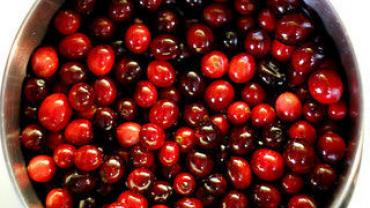
While enjoying your holiday meals feel free to load up on the cranberries. Quite diverse cranberries can be used in salads punches vegetable dishes relish pies and desserts while dried cranberries can be used in risottos or bread. More than a wonderful side dish or sauce however cranberries are a nutritious powerhouse as they contain compounds known as proanthocyanidins (PACs) which give them their rich vibrant color and much of their antioxidant power.
Grown in North American peat bogs Native Americans used cranberry for treating bladder and kidney diseases. Perhaps this is why cranberry is mostly associated with urinary tract infection (UTI) prevention. Research shows a variety of UTI- preventative effects for this tiny fruit. Strong evidence supports the use of cranberry for the prevention of UTIs in young and middle-age women while cranberry was also proven effective for prophylaxis in children with recurrent UTIs over one month of age. In addition patients with ureteral catheter placement had a reduced rate of UTI after supplementing with American cranberry (PAC 120 mg).
Bacteriuria and pyuria tended to decrease in female nursing-home residents when supplemented with cranberry capsules of 36 to 108 mg PACs. These are some reassuring findings since UTIs are one of the most commonly diagnosed infections in both hospitalized and community-dwelling older adults.
Cranberry-derived PACs were also examined for the prevention of Candida albicans. Using artificial urine C. albicans biofilms were coincubated with cranberry PACs at serially increased concentrations and those greater than 16 mg/L significantly reduced biofilm formation in all C. albicans strains tested due to their anti-adherence properties and/or iron chelation.
Using the same line of thinking lower incidence of acute radiation cystitis was found in prostate cancer patients where those taking cranberry supplementation experienced less pain and burning than placebo.
Studies seem to be in concurrence that the anti-adherence properties are the reason cranberry is better at prevention than actual treatment when the bacteria have already attached. (Maybe thats why it doesn't stick to the wall of the can.) PACs from cranberry juice cocktail are composed of a particular structure of repeating epicatechin units and it is this structure that is considered to be a prerequisite for cranberry's anti-adhesion property.
Cranberry mouthwash was examined to test this inhibition of bacterial adhesion in the oral cavity. While more studies are needed the mouthwash did indeed effectively inhibit caries formation. In examination of preventing dental caries formation antifungal and antibiofilm activities of dry extracts of cranberry fruit and two other red fruits were assessed on Candida albicans and Candida glabrata yeasts. In low concentrations cranberry extract displayed significant anti-adhesion activity against Candida mainly to C. glabrata with antiobiofilm activity against C. albicans. Cranberry-derived polyphenols were also shown to interfere with and prevent growth of periodontopathogen biofilm formation. This is noteworthy as these pathogens form the inflammatory disease periodontitis.
Lastly consider these interesting new findings as you enjoy your cranberries: